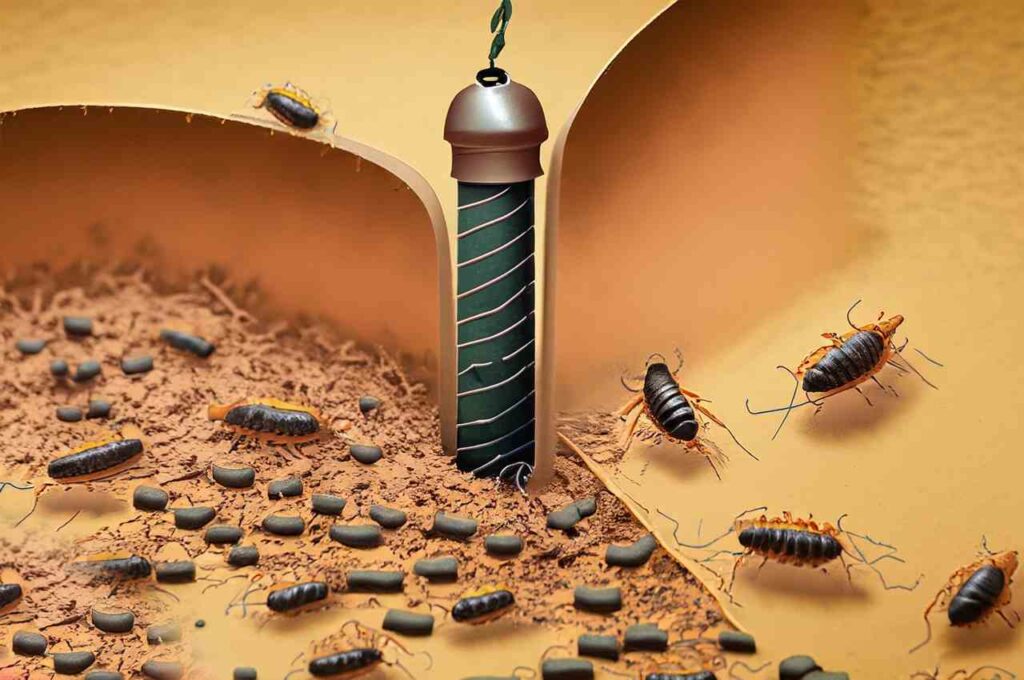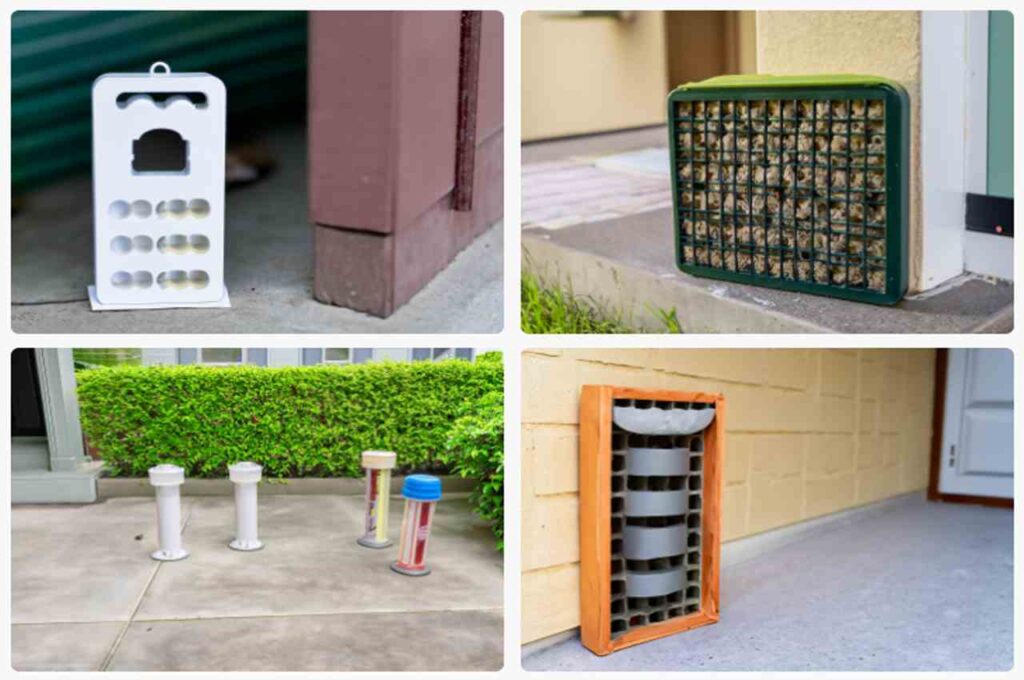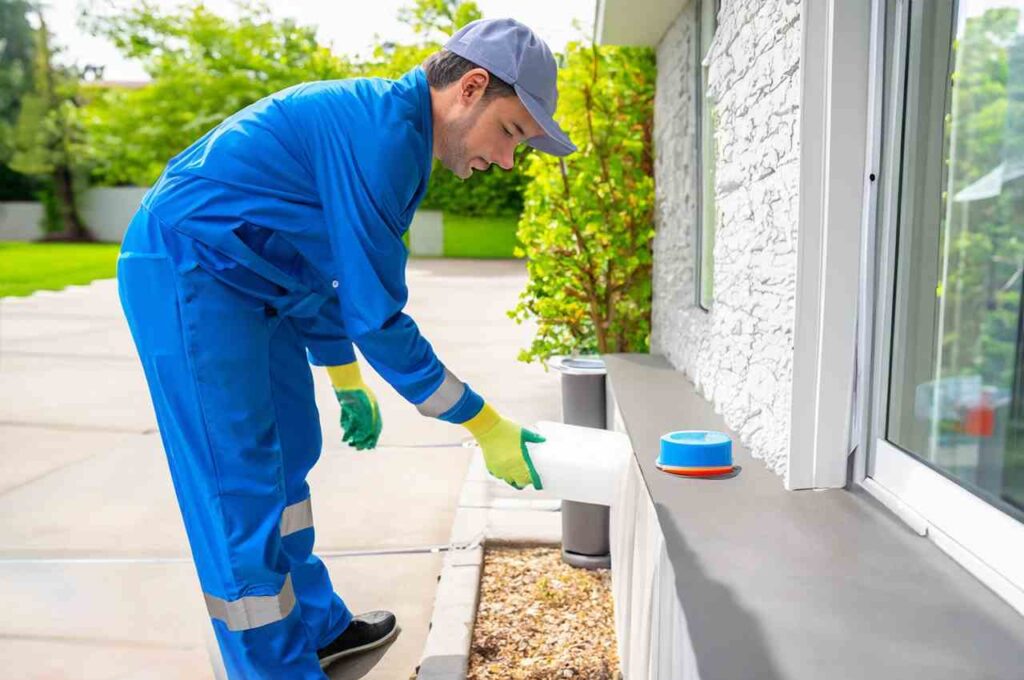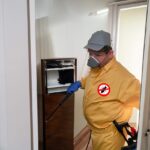A Comprehensive Guide to How Termite Traps Work. In this post, we’ll explore the termite traps and how they work, types of traps used, and their effectiveness in safeguarding your home. Read on to learn how termite traps work and how they can prevent damage to your most valuable investment—your house.
How termite traps work?
Various attractants are used by termite traps to lure termites into the trap. These attractants may be light sources, vibrations, chemical pheromones, treated wood, or light sources. Termites find the treated wood to be more alluring since it has been injected with chemical attractants. Pheromones attract termites to the trap by imitating their communication signals. Occasionally, vibrations or light work as attractants to draw termites to the area around the trap. Termite populations are efficiently managed after they are trapped since they are either chemically eliminated or made unable to leave. While reducing negative effects on the environment and health concerns to people, this bait-and-kill method assists in protecting houses against termite infestations.
Understanding the mechanisms that attract termites
The attractants employed in termite traps come in many different varieties. Among the most popular attractants are:
- Wood: Termite traps often include pieces of wood that have been chemically treated to attract pests. Termites find the wood more alluring due to the chemical attractant.
- Pheromones: Pheromones may also be used to bait termite traps. Termites are drawn to the trap by the pheromones and destroyed there.
- Light: Some termite traps make use of light to draw in their prey. Termites are drawn to the trap by the light, where they are subsequently exterminated.
- Vibration: Some termite traps use vibration to draw termites in. Termites are drawn to the trap by the vibration and destroyed there.

Termite attraction is a complicated and poorly understood scientific phenomenon. But according to experts, termites employ a variety of senses, including touch, taste, and smell, to locate food and mates. Additionally, they think that termites utilize pheromones to communicate and mark their territory.
One or more of these attractants are used by termite traps to entice termites into the trap. Once within the trap, the termites are either chemically destroyed or rendered immobile, rendering them dead.
Making your property less appealing to termites is the greatest approach to avoid a termite infestation. This entails filling up any flaws or cracks in your foundation or external walls, maintaining a clean, clutter-free home, and setting up trees and bushes far from your house.
Type of Termite Trap

| Type of Termite Trap | Method of Terminate Termites | Description |
|---|---|---|
| Baited Traps | Chemical termination | Attracts termites using wood or pheromones. Chemicals destroy termites in the trap. |
| Sticky Traps | Sticky substance capture | Coated with a sticky material that attracts termites to the trap. |
| Electric Traps | Electric current termination | Electric current kills termites in the trap. |
| Funnel Traps | Chemical or confinement termination | Used to confine termites in a container and kill them with a chemical. |
Effectiveness of Different Termite Traps
| Effective Against | Trap Type | How They Work |
|---|---|---|
| Subterranean Termites | Baited Traps | Baited traps attract termites using treated wood. The bait poisons termites. |
| Subterranean and Drywood Termites | Sticky Traps | Sticky traps' sticky surfaces catch termites. Termites die from trapping. |
| Subterranean and Drywood Termites | Electric Traps | An electric current kills termites in electric traps. |
| Subterranean and Drywood Termites | Funnel Traps | Funnel traps catch termites in containers where they are chemically treated or trapped. |
Installation Guidelines for Termite Traps
According on the manufacturer’s instructions and the kind of trap, different termite traps need different installation procedures. Here are some basic pointers for setting up termite traps, though:
1. Pick the appropriate place. In locations where termites are likely to be found, termite traps should be set up. This includes the vicinity of your home’s foundation, next to bushes and trees, and in crawl spaces.
2. Set up the location. The location where the trap will be installed has to be tidy and debris-free. Termites will be drawn to the trap as a result.
3. As directed by the manufacturer, install the trap. To ensure that the trap is fitted properly, pay close attention to the instructions.
4. Inspect the trap often. It is important to routinely examine the trap to see whether it has been set off. The trap needs to be changed if it has been set off.
Signs That Your Traps Need to be Replaced
There are a few indicators that it may be time to change your termite traps:
- The attractant has lost its potency. It could be time to switch out the attractant if termites are no longer attracted to the trap.
- The trap has been harmed. The ability of the trap to capture termites may be compromised if it is destroyed.
- Termites were seen in the trap. Termites in the trap indicate that it is functioning, but if it is full, it could need to be replaced.
The trap has run its course. The majority of termite traps have a shelf life. The termites may not be captured if the trap has expired.
Replace your termite traps as soon as you see any of these symptoms. Termite traps are available online or at the majority of hardware shops. It’s crucial to choose a termite trap that is made for the kind of termites that are prevalent in your region.
Maintenance Schedule for Termite Traps
The kind of trap and the manufacturer’s instructions determine the termite trap maintenance plan. However, the majority of traps need to be maintained and examined once a month.

When maintaining termite traps, you should check the following things:
- Examine the attractant: The attractant in the trap may need to be changed out from time to time.
- Inspect the trap for damage: Termites or other pests might have harmed the trap. Replace the damaged trap if necessary.
- Check the trap for termites. If you find any, the trap is likely to be effective. To have your house inspected for termite infestation, however, you need also call a pest treatment specialist.
You may need to examine and repair your termite traps more regularly if you reside in an area with a high risk of termite infestation.
Pros and Cons of Termite Traps
| Pros of Termite Traps | Cons of Termite Traps |
|---|---|
| Relatively inexpensive | Not always effective at killing termites |
| Easy to purchase and install | May not detect all infestations |
| Convenient placement for early detection | Ineffective against large infestations |
Frequently Asked Questions
How do termite traps attract termites?
Various attractants are used in termite traps to entice termites. Among these attractants are chemically treated wood that makes it more alluring to termites, pheromones that imitate termite signals and entice them to the trap, light sources that draw termites close to the trap, and vibration mechanisms that produce vibrations that termites are sensitive to and draw them there. These attractants take use of the termites’ inherent tendencies and preferences to lure them into the traps, where they are then killed.
How to check termite traps?
Effective termite trap checks begin with pinpointing the traps, which are often placed around the home’s foundation, next to trees and bushes, and within crawlspaces. Look carefully for any indications of termite activity in the traps, such as the presence of termites or telltale indicators like frass (termite droppings) or mud tubes. It’s essential to change the traps if they are termite-filled in accordance with the manufacturer’s instructions, usually every six months to a year. Regular cleaning is suggested to preserve the efficacy of traps that aren’t yet full. These actions are essential to ensure that your termite traps continue to function as an early warning system and technique of mite infestation prevention.
How long do termite traps take to work?
Termite traps require different amounts of time to function, depending on the kind of trap used and the severity of the termite infestation. If used in places where termites are actively present, sticky traps and electric traps may provide quick results. It may take weeks or even months for these traps to successfully catch or kill enough termites in situations of severe infestations, however. Contrarily, funnel traps usually take longer to function since they need to draw termites to the trap before killing them. Termite management may take months or even years in cases with significant infestations. While termite traps might be useful for early identification and infestation reduction, it’s crucial to keep in mind that they might not be enough for severe infestations, needing expert pest management assistance.
How does ground termite traps work?
Ground termite traps work by luring termites with an alluring bait that is put near a house’s foundation. This bait is often made of substances that termites like eating, including wood or cellulose. Termites are attracted to the bait, and when they eat it, they unintentionally swallow a slow-acting poison. The termites eventually perish once this poison takes action over time. Strategically placed ground termite traps serve as a deterrent and aid in defending the building from possible termite damage in regions with significant termite activity.
Are termite traps environmentally safe?
Termite traps’ environmental safety varies based on the particular trap design and chemicals used. Some termite traps include chemicals that might possibly contaminate soil and water, endanger other creatures, and have negative environmental consequences. On the other hand, there are non-chemical termite traps that use physical processes to get rid of termites, including sticky substances or electric currents, making them a more eco-friendly choice. People who care about the environment should think about using non-chemical or chemical termite traps that have a low effect on the environment while implementing termite control procedures.
Are chemicals used in termite traps to kill termites?
Both chemical and non-chemical termite traps are available. Chemical termite traps use fumigants, poisons, or baits to get rid of termites. While poison traps kill termites upon contact with the poisonous chemical, baits attract termites with poisoned food sources. Gases are released by fumigant traps, which suffocate termites. On the other side, non-chemical termite traps kill termites using physical means such as electricity, drowning, or sticky substances. The decision between chemical and non-chemical traps is based on personal demands and preferences. Non-chemical traps are an option for those who are worried about chemical use, but it’s crucial to remember that they may not always be as successful as their chemical equivalents.
How often should I inspect or change my termite traps?
Termite trap maintenance requirements vary depending on the kind of trap and the manufacturer’s recommendations. In general, it’s a good idea to maintain and conduct monthly checks of termite traps. Make careful to examine the attractant within the trap during these checkups and replace it if necessary. Additionally, check the trap for any indications of termite or other pest damage; if you find any, replace the trap right once.
What are the signs that termite traps are working?
There are a number of indicators that termite traps are operating efficiently. Although certain traps may attract termites without immediately eradicating them, the presence of termites within the trap is a definite indication of their effectiveness. Second, the disappearance of the attractant within the trap indicates that termites have been drawn to it. But keep in mind that other insects, such as ants, could also eat the attractant. Thirdly, look for any evidence of damage to the trap since a broken trap would not be able to efficiently draw in or get rid of termites. Last but not least, a trap that has termite frass—the waste that termites produce—inside of it proves that termites have been using it. These indications of termite trap effectiveness are encouraging, but they should not be depended upon as the only defense against termite infestations. Professional inspections are essential for thorough termite control on a regular basis.
Can I use termite traps as a standalone termite control method?
Termite traps are not a stand-alone termite management method, but they may be an important part of a plan by spotting termites early and avoiding serious infestations. These traps offer benefits, including being reasonably priced, simple to operate, and capable of early termite detection. They may not be able to completely eradicate termites, find every infestation, or deal with serious termite issues, thus they do have limits. Therefore, for total termite protection, it is advised to employ termite traps in combination with other preventative measures and to take expert termite control services into consideration.
Do termite traps work for all termite species?
Not every species of termite responds well to termite traps. Their effectiveness is influenced by a number of variables, such as the particular trap type, the kind of termites present, and the location of the trap. Different termite traps are made to attract and capture certain termite species, such drywood termites or subterranean termites. It is recommended to speak with a pest control expert who can identify the termite species present in your region and suggest the best traps and trap placements for efficient termite management in order to establish which traps are acceptable for your circumstance.
Are there any specific instructions for installing termite traps?
Yes, precise installation instructions exist, and depending on the kind of trap, these instructions may differ. In general, it’s critical to choose the proper placement for the traps, such as close to the foundation of your house, close to probable termite entrance sites, or in locations where termite activity is known to occur. To efficiently attract termites, the installation location must be cleaned up and made debris-free. For the trap to work well, installation must exactly follow the manufacturer’s instructions. In order to keep the trap effective, it must be regularly checked for termite activity. If the trap has been triggered, it must be changed in accordance with the manufacturer’s instructions.
How effective are termite traps in comparison to other termite treatment techniques?
Comparing termite traps to other termite management techniques, they both have benefits and disadvantages. Termite traps are useful for spotting termite activity early on and may eventually aid in the population’s decline. They may not be as efficient, however, in getting rid of serious termite infestations. On the other hand, more thorough techniques that may completely rid the building of termites include bait stations, termite fumigation, and termite tenting. In contrast to fumigation techniques, which employ gases to kill termites, bait stations use slow-release poison. Particularly with termite tenting, complete covering is guaranteed. The selection of a termite control strategy relies on the severity of the infestation and personal preferences; some homeowners choose a mix of strategies for increased defense.
Can termite traps be used to treat and prevent infestations at the same time?
Yes, termite traps may be used for the prevention and treatment of termite infestations. These traps may serve as an early warning system by catching termites before they can develop a colony in your house when set strategically in locations where termite activity is likely to occur. They may also help to lessen the number of termites present when used in locations where termite activity is suspected, aiding in the treatment of an existing infestation. While termite traps may be an important part of termite treatment, it’s important to understand that they are not always successful and may not completely get rid of an infestation. Additionally, for complete protection, they should be used in combination with other termite control techniques.
Are termite traps suitable for both indoor and outdoor use?
Yes, depending on the kind of trap and its unique design, termite traps may be employed both inside and outside. Sticky traps, electric traps, and funnel traps, among other popular termite trap designs, are adaptable enough to be used in both indoor and outdoor situations. To be sure that you are utilizing the right trap for the particular area and your termite management requirements, you must carefully read the manufacturer’s instructions and recommendations for each trap. Following the manufacturer’s instructions is essential to maximizing the efficiency of any traps since some may be better suited for certain situations.
Do I need a professional to install my termite traps, or can I do it myself?
Depending on the kind of trap being utilized, there are many ways to install termite traps. Sticky and electric termite traps, for example, are quite easy to set up and may be completed by homeowners. To guarantee appropriate installation, it’s essential to carefully follow the manufacturer’s instructions. Contrarily, funnel traps may need expert installation owing to its intricacy and unique location requirements. The placement of these traps may need specific equipment and knowledge, so seeking professional help is a wise move. Therefore, the decision to install a termite trap yourself vs hire a professional will rely on the particular kind of termite trap and how comfortable the homeowner is with the installation procedure.
What should I do if I find termites in the traps?
It’s essential to act quickly to prevent any harm to your home if termites are found in the traps. First and foremost, speak with a qualified pest control specialist who can evaluate the situation, establish the scope of the termite infestation, and provide an effective treatment strategy. Avoid agitating the termites since doing so might disperse them and make the treatment more difficult. Seal any gaps or cracks in the external walls or foundation of your house as well, since termites might use these openings. As termites are drawn to moisture and rotting, keeping your house clean and clutter-free is crucial. Finally, to prevent termites from readily reaching your property, think about growing trees and plants at a safe distance from your house. By taking these proactive steps, you can protect your house from possible termite damage.
Who invented termite traps?
The termite-baiting technique known as Sentricon® is attributed with being invented by Nan-Yao Su, a renowned entomologist at the University of Florida. To efficiently get rid of termites, this novel technique uses a slow-release poison cloaked in an alluring bait. The world’s first termite bait distribution system was researched and created by Nan-Yao Su in partnership with the Dow Chemical Company during his graduate studies. Since its inception in 1995, the Sentricon® system, which is the outcome of his partnership, has gained widespread recognition and is used for termite treatment. While Nan-Yao Su is credited with developing the technology for termite traps, it’s important to stress that hiring a reputable pest control firm is still the most effective way to get rid of termites.
- How do termite mounds help regulate temperature? - 7 January 2024
- 10 Effective Termite Control Methods That Actually Work - 4 January 2024
- How Long Does It Take for a Termite Mound to Form? - 21 December 2023




